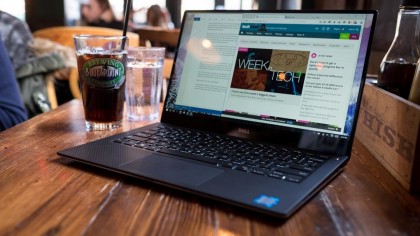Why you can trust TechRadar
The XPS 13 doesn't only offer less space along its borders – it's more compact in general. It's only 0.59 inches (1.5cm) tall, 11.97 inches (30.4cm) wide, and 7.87 inches (20cm) long. Compared to last year's model, the new XPS 13 has exactly the same chassis but it weighs 0.13 pounds (0.6g) more, thanks to its denser battery.
By comparison, the MacBook Air seems like a needlessly large, 13-inch laptop measuring 12.80 x 8.94 x 0.67 inches (32.5 x 22.7 x 1.7cm). Also, compared to slim and small Yoga 900, Dell's Ultrabook is 0.78 inches (1.98cm) narrower and nearly an inch shallower 0.15 inches (0.38cm) but equally as thick.

The XPS 13 is also one of the lightest devices on the market. The standard, full HD model weighs only 2.7 pounds (1.2kg). Meanwhile, the touch-enabled, quad HD model weighs slightly more at 2.93 pounds (1.33kg), thanks to the added digitizer and cover glass. To put the XPS 13 in perspective, the Lenovo Yoga 900 weighs 2.84 pounds (1.29kg) and the 13-inch MacBook Air weighs 2.96 pounds (1.35kg).
Of course, it's no competition for the lightweight champion, the Lenovo LaVie Z, which weighs only 1.87 pounds (0.85kg).
As you'll soon see, this year's XPS 13 is brimming with the latest high-end laptop components. From the newest Skylake Intel Core i7 chip to gobs of RAM and storage, the setup with which I wrote this review should see you through well into 2018 and possibly beyond.

Spec sheet
- CPU: 2.3GHz Intel Core i5-6200U (dual-core, 3MB cache, up to 2.8 GHz with Turbo Boost)
- Graphics: Intel HD Graphics 520
- RAM: 8GB LPDDR3 (1,866MHz)
- Screen: 13.3-inch QHD+ (3,200 x 1,800) InfinityEdge touch display
- Storage: 256GB PCIe SSD
- Ports: 1 x USB 3.0, 1 x USB 3.0 w/PowerShare, 1 x USB Type C and Thunderbolt 3, SD card reader, headset jack
- Connectivity: DW1820A 2x2 802.11ac 2.4/5GHz; Bluetooth 4.1
- Camera: 720p widescreen HD webcam with dual array digital microphones
- Weight: 2.93 pounds (1.32kg)
- Size: 11.97 x 7.87 x 0.35 – 0.59 inches (W x D x H) (30.4 x 19.9 x 0.89-1.5mm)
Priced at $1,449 (£1,149, AU$1,999), what you see above is the second best configuration that the XPS 13 you can put together. The UK model is slightly different in that you can't get the QHD+ screen upgrade without automatically bumping up to an Intel Core i7 CPU.
For quite a bit less, you could get a Lenovo Yoga 900 with double the storage and a faster Core i7 processor for $1,299 (£1,449, AU$2,599). Similarly, you can pick up the 13-inch MacBook Air for $1,449 (£1,209, AU$2,249) after upgrading to an Intel Core i7 CPU and increasing the memory to 8GB – but there's nothing you can do about the significantly duller, 1,440 x 900 display.
Sign up for breaking news, reviews, opinion, top tech deals, and more.
If a high-resolution screen is superfluous to you, there's the option of dropping down to the non-touch, 1080p version for $999 (£849, AU$1,799). In the US, you'll also find a unique $799 configuration, edging it into the budget space with only an Intel Core i3 CPU, 4GB of RAM and 128GB SSD.

That all said, I would recommend going for broke when you configure the XPS 13. The battery and processor are more than enough to keep the high-res screen running for a decent chunk of time.
In terms of aesthetics, the QHD+ model also just looks better. In front of the high-res screen is an an edge-to-edge sheet of Corning Gorilla glass that makes top section of the notebook look like it's made of nothing but the display.
Though you can to tap on the XPS 13's touchscreen, the Lenovo Yoga 900 offers a full tablet experience, with its convertible design and lower price point. And if you're looking to save as much as possible, the MacBook Air is the most affordable notebook in Apple's lineup. Though, there are some decent Windows-powered alternatives, including the Asus Zenbook UX305.
Current page: Specifications and value
Prev Page Introduction and design Next Page Performance and features